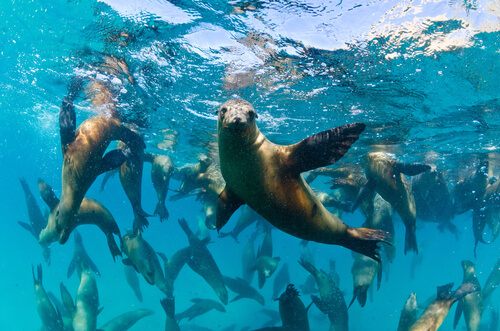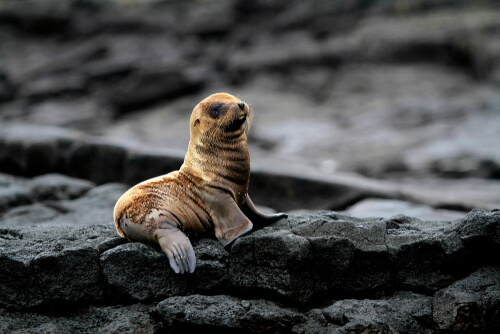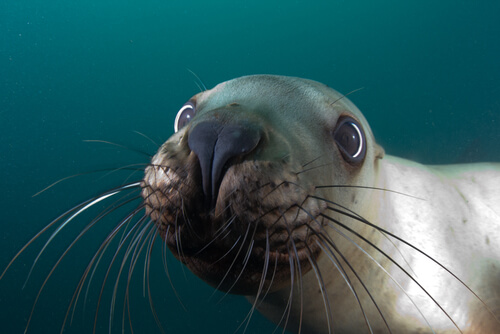
| Kingdom | Animalia |
| Phylum | Chordata |
| Class | Mammalia |
| Order | Carnivora |
| Family | Otariidae |
| Genus | Eumetopias, Neophoca, Otaria, Phocarctos, Zalophus |
| Species | Various |
| Niche | Carnivorous marine mammal |
| Length | 610 ft (1.8-3.0 m) |
| Weight | 220-2 200 lb (100-1000 kg) |
| Lifespan | 20-30 years |
| Social Structure | Social |
| Conservation Status | Three species endangered |
| Preferred Habitat | Coastal marine waters |
| Average Number of Offspring | 1 |
| Main Prey Species | Fish |
| Predators | Orca, various large shark species |
The Basics
The sea lion is a large marine mammal of the clad Pinnipedia, or pinnipeds, characterized by their external ears and their ability to walk on all fours using their long front flippers, an ability absent in seals. There are five living genera of sea lion and they can be found in the coastal waters in all of the world’s oceans at subarctic to tropical latitudes.
Description
Sea lions are large and streamlined with a smooth appearance and short, thick hair. They have large front flippers and a tail fin that allows them to swim proficiently. They are also able to walk while on land, although they are not nearly as graceful out of the water as they are in the water. Male sea lions can weigh up to 300 kg (660 lb) and grow to 8 ft (2.4 m) long, depending on the species. Females are generally smaller, normally weighing 100-200 lb (45-90 kg).

There are various species of sea lion belonging to five extant genera. The largest species is the Steller’s sea lion, which can weigh up to 2 200 lb (1 000 kg) and grow to a length of 10 ft (3.0 m). They are related to walruses and seals, but lack the long tusks of walruses and retain the ability to ‘walk’, unlike seals. Together with fur seals, they form the family known as Otariidae or eared seals, in reference to their characteristic external ear flaps.
Distribution and Range
With various species among five genera, sea lions can be found in most of the world’s oceans in all subarctic to tropical waters in both hemispheres. California sea lions and Steller sea lions are common along the west coast of North America, while the Galapagos sea lion is native to the coastal areas of northern South America near Ecuador. South America also hosts the South American sea lion (Otaria flavescens), which lives primarily along the Chilean coast, while New Zealand and Australia each have distinct species of sea lions along their shores.
All sea lions inhabit coastal waters, generally remaining close to known ‘haul-out spots’, locations where they will exit the water and rest on the rocky shores. These haul-out spots may be small, rocky islands or remote shorelines. Sea lions are often seen lounging on man-made structures such as navigation aids and docks. When in the water, sea lions are adept swimmers, playing and hunting with speed and grace. They are capable of diving to great depths of up to 900 ft (272 m) thanks to special adaptations and the ability to remain underwater for minutes at a time.
Diet and Predators
Sea lions are carnivorous and are voracious predators. Depending on the species and the region, they will eat a variety of items including large fish species such as salmon and tuna. Where they both occur, sea lions will also feed on penguins. Some species have also been observed feeding on young seal pups. They also eat squid, various crustaceans and mollusks, small shark species, and octopus.
Despite being larger than many species and a fierce predator itself, sea lions have other more formidable predatory species to worry about as well. Orcas are apex predators in the ocean and almost any animal can fall victim to them, including sea lions. Pups in particular are prone to predation and orcas have been known to identify sea lion breeding grounds, often engaging in fascinating hunting activities to catch one. In New Zealand, for example, whales risk beaching themselves while rushing up on the shore in chase of young sea lions swimming and playing in the surf zone. Large sharks such as the great white shark will also hunt sea lions, pups in particular.
Reproduction
Reproductive behaviors vary somewhat between species of sea lions. However, many features are common to most species. Adult males generally try to establish a territory in the spring. Later, the female will arrive in the area as if to assess the territories available. During this time, infighting between males will increase significantly, with vicious fights and aggressive displays occurring in defense of their territories.
Following copulation, females will often delay fertilization for up to three months, sometime mating with other males later in the breeding season instead. The gestation period is normally about 9 months, at which point one pup is born to each female although twins do rarely occur. In many species, females will mate again within weeks of giving birth while continuing to care for her new pup, beginning the annual cycle anew.
Sea lions reach sexual maturity at about 5-7 years of age and can live for up to 30 years. Currently, three species are listed as endangered while the rest are not currently threatened. However, as global climate change causes drastic changes in marine habitats around the world, certain populations are indeed under pressure.

Fun Facts about Sea Lion!
Sea lions are ubiquitous throughout the world and commonly observed by humans in bays, harbors, or at the zoo. They are highly intelligent and, in captivity, have been trained to perform many entertaining tricks. However, some of the most fascinating aspects of these charismatic species are better observed in the wild.
The Lion of the Sea
Perhaps fitting with their common name as the lions of the sea, sea lions are voracious predators and have seemingly insatiable appetites. They will often feed in groups and effectively gorge themselves before hauling out of the water onto a rocky shoreline to digest and rest. Sea lions are known to eat up to 8% of their body weight at a time. For a 180 lb human, this is the equivalent of eating 14.4 lb (6.5 kg) of food in a single meal. Sea lions can eat prey larger than their head, such as the large Pacific octopus, all at once. There have also been accounts of steller sea lions catching sharks and consuming the pups of northern fur seals. It seems the sea lion indeed has been aptly named.
Sea Shepherd
Sea lions are known to have many adaptive behaviors and interesting hunting and feeding strategies. Most are unique to their habitat and the prey available in it. For example, the Galapagos sea lion (Zalophus wollebaek) has been demonstrated to engage in interesting herding behavior while hunting. As a group, the sea lions will herd tuna into shallow lagoons where they will be much easier to hunt. Tuna are large and powerful predators themselves, yet the sea lions seem to have found a safe way to hunt them using their numbers and intelligence to their advantage.

SCUBA Sea Lion
Sea lions are capable of diving to deep depths in search of food. At depth, the pressure from water increases. This presents a risk due to the potential buildup of nitrogen gas in the tissues of animals, a phenomenon well-known to SCUBA divers. Many marine animals have special adaptations that allow them to inhabit these environments. While humans must return from depth slowly to allow the gases to escape their system at a reasonable rate, sea lions have specially adapted lungs that allow them to prevent the exchange of gases in their system while they are underwater.
This adaptation allows them to move up and down in the water column quickly in search of prey without risk of dangerous gas buildup in their circulatory system. However, this also requires their muscles to be fully loaded with oxygen prior to diving, as the air in their lungs is entirely expelled before diving, another necessity for this unique adaptation to remain effective.
